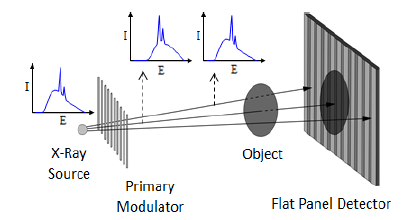Investigators at Georgia Tech have developed a method that utilizes primary beam modulation to enable single-scan DECT on a conventional CT scanner. This method utilizes limited hardware components to simultaneously acquire high and low energy datasets. These images are reconstructed from projections via an iterative CT reconstruction algorithm. Preliminary studies using a copper modulator on a cone-beam CT system show promise for performing high-quality single-scan DECT imaging and distinguishing between different materials through basis material decomposition.
- More affordable than currently available comparable DECT components.
- Eliminates the need for two scans, resulting in a shorter imaging time and reducing issues associated to patient motion during scans.
- Compatible with most CT scanners, including cone-beam CT.
- CT imaging geometry with primary modulator makes it possible to combine the DECT method with effective scatter correction on the same scanner.
- Able to produce CT images comparable in image quality to conventional CT images.
The method can be used to add DECT capabilities to any existing CT system, including cone-beam CT systems, making DECT imaging more accessible to institutions world-wide.
With continued advances in computed tomography (CT), dual-energy CT (DECT) has emerged as a promising imaging technique with numerous applications. With DECT, two data sets of the same anatomic location are acquired using different x-ray spectra. By exploiting the differences in x-ray attenuation of tissues within the body, DECT can characterize tissue composition to a greater extent than with the single-energy technique. In order to perform DECT scans, institutions must purchase expensive hardware or acquire high and low energy datasets using two scan settings. The latter technique increases the data acquisition time and the probability of patient movement between scans, which could render the acquired data useless. Furthermore, these alternatives are not compatible with certain systems, such as cone-beam CT scanners.

